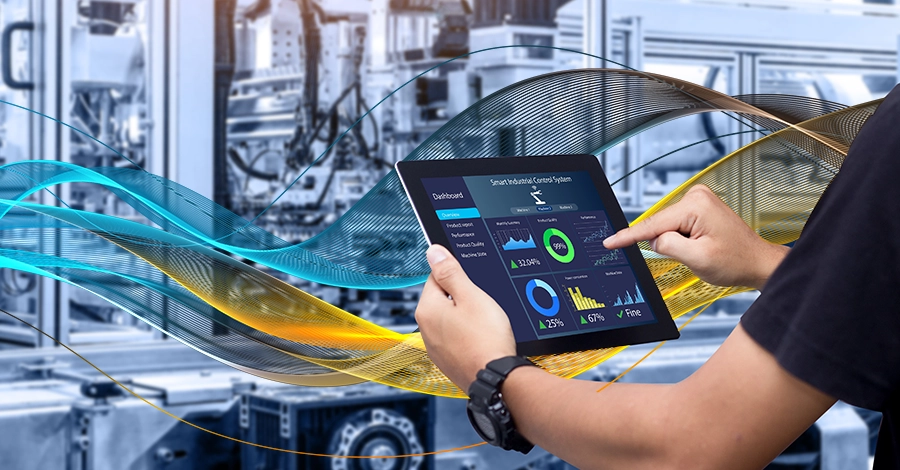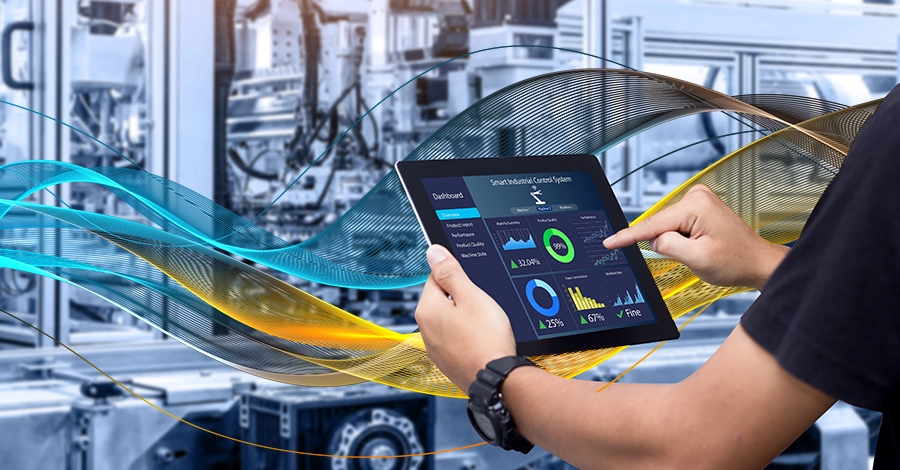

Josh Pearce
Business Development Manager
Consumer/Industrial
Picture this: A manufacturing plant discovers that 49% of its energy consumption happens during off-hours when no production is running. Within a week of installing smart meters and adjusting HVAC schedules, energy use drops by 38%—all without interrupting a single production cycle. This isn’t a hypothetical scenario; it’s happening right now in factories across the globe as manufacturers embrace connected infrastructure as part of their Industry 4.0 transformation.
But there’s a challenge that keeps operations managers up at night: How do you integrate thousands of IoT sensors, smart lighting systems, and connected HVAC controls into a production environment where even seconds of downtime can cost millions? The answer lies in a careful balance of digital innovation and operational pragmatism, or what we at Eclipse call “automation that amplifies rather than interferes.”
In this article
- Connected infrastructure (smart HVAC, lighting, and meters) is becoming mainstream in manufacturing, with Fortune-500 plants achieving average energy savings of 7.5% through smart metering alone.
- IT/OT convergence remains challenging—70% of manufacturers report incomplete integration between information technology and operational technology systems.
- Leading manufacturers like Audi, Johnson Controls, and Siemens Energy demonstrate how brownfield integration can connect legacy equipment without disrupting production.
- Three-tier architecture (edge-fog-cloud) enables real-time control while maintaining reliability through local processing.
- Success requires strong cybersecurity, standardized protocols, and focus on actionable data rather than data overload.
Towards a truly connected factory
Modern factories are increasingly integrating connected HVAC, lighting, and metering systems as essential components of their digital manufacturing transformation. According to recent IDC projections, manufacturers will be spending billions of dollars on IoT initiatives by 2025, with smart building systems playing a crucial role in meeting net-zero targets and managing rising energy costs.
Johnson Controls, for example, transformed a sprawling US manufacturing site by implementing its OpenBlue digital platform with connected HVAC systems. Within six months, the plant achieved over 90% HVAC uptime, reduced maintenance hours by 50%, and added $5 million to profit through fewer breakdowns. This wasn’t just about energy savings, but about creating a responsive, intelligent infrastructure that actively supports production goals.
As for lighting, it’s important to note that besides providing light, today’s industrial LED lights can also include sensors that monitor temperature, humidity, and power quality across the entire plant. Some systems even enable automated demand-response, dimming non-critical lighting during peak loads without any impact on production schedules.
Bridging the IT/OT divide without disrupting production
Perhaps the biggest challenge in implementing connected infrastructure is what industry experts call the “IT/OT convergence challenge.” Approximately 70% of companies report that integrating their information technology (IT) systems with operational technology (OT) remains incomplete, often because of legacy mismatch. You might have PLCs from the 1990s running mission-critical processes alongside brand-new AI-powered vision systems. Legacy equipment using Modbus protocols must somehow communicate with cloud platforms expecting MQTT or OPC-UA.
Siemens Energy elegantly solved this challenge at 18 worldwide plants by using AWS IoT SiteWise Edge combined with Domatica’s gateway technology. This approach allowed them to connect diverse protocols without overhauling existing machines.
The result? They halved data-collection time, reduced maintenance costs by approximately 25%, and boosted machine uptime by up to 15%, all while keeping legacy equipment in place.
The secret lies in what’s known as “brownfield integration,” in which existing equipment is connected through edge gateways and protocol translators rather than replacing entire systems. As one Siemens engineer explains, “An electrician can plug an edge box near an air handling unit or meter, and within minutes feed live data into the cloud, bringing new visibility to legacy assets.”
The three-tier architecture: Edge, fog, and cloud
Successful connected infrastructure implementations typically follow a three-tier architecture that balances real-time responsiveness with enterprise-scale analytics:
Edge layer: Smart sensors and PLCs perform immediate processing and protocol translation. Critical control loops like thermostat adjustments or safety shutdowns remain local, ensuring millisecond response times even if cloud connectivity is lost. This is where Eclipse’s expertise in industrial automation solutions becomes crucial, ensuring that connectivity enhances rather than compromises operational reliability.
Fog layer: Manufacturing Execution Systems (MES) and data historians provide the intelligence bridge between shop floor and enterprise. Here, real-time data validation ensures quality and consistency before information moves upstream.
Cloud layer: Enterprise-scale analytics and compliance management happen here, with platforms like AWS or Azure providing virtually unlimited storage and processing power while maintaining strict governance controls.
This architecture proved its worth at Audi’s new Böllinger Höfe plant, part of Volkswagen’s “360factory” initiative. Using Cisco’s Edge Cloud network, Audi connected thousands of existing machines, robots, and sensors without replacing legacy equipment. The result is a carbon-neutral facility where digital tracking and AI-supported monitoring run alongside assembly lines, achieving both sustainability and productivity gains.
Turning data into action, not overload
One of the most overlooked challenges in connected infrastructure is data overload. Millions of sensor readings mean nothing without context and action. A North Carolina State research study of 87 manufacturing units from a Fortune-200 company found that those achieving the best results—an average 7.5% reduction in energy use—weren’t just those with the most sensors, but those whose managers actively used the data to make decisions.
The human factor matters enormously. That same study showed that factories whose managers engaged with smart meter data saw the biggest savings. This underscores a critical point: connected meters and analytics only boost productivity when integrated into operations rather than being a passive overlay.
Eclipse’s approach to automation integration services addresses this challenge directly. By focusing on high-value data streams and clear analytics dashboards, we help manufacturers identify actionable insights rather than drowning in data. Whether it’s correlating energy spikes to specific processes or predicting equipment failures before they occur, the goal is always operational improvement, not just measurement.
Security without sacrificing agility
With manufacturing now accounting for more than half of all IoT cyber attacks, security can’t be an afterthought. Every connected sensor, every data stream, every integration point becomes a potential vulnerability that must be secured without compromising operational speed.
Best practices include strict network segmentation with separate factory networks protected by industrial firewalls, use of private 5G or secure wireless for real-time data transmission, and industrial-grade VPNs and routers designed for factory environments. These measures ensure that connected infrastructure enhances security rather than creating new vulnerabilities.
The ROI equation: Connected infrastructure that pays for itself
While upfront costs for advanced meters, controls, and software require investment, the payback periods are often surprisingly short. Atlas Global Solutions, a packaging plant that upgraded to smart LEDs, achieved a 75% reduction in lighting energy costs and a 20% productivity gain.
The benefits extend beyond direct cost savings:
Asset tracking via smart lighting improves inventory management and workflow
Predictive maintenance reduces unplanned downtime
Dynamic climate control improves worker comfort and alertness
Real-time monitoring enables rapid response to quality issues
Demand-response programs cut energy costs without affecting production
Eclipse’s approach to smart factory transformation
At Eclipse Automation, we understand that successful digital manufacturing transformation requires more than just installing sensors and software. Modern factories produce enormous amounts of unstructured data, but to get the full benefits of industry 4.0 and generative AI, that data needs to be digitized, structured, and integrated into an overall automation strategy.
Eclipse’s ability to converge the physical and digital aspects of factory automation means that these efforts will bring maximum return and competitive advantage. Our vertical integration approach, advanced engineering services and data digitization and automation services ensure that connected infrastructure enhances rather than hinders your manufacturing operations. The automation of digitizing factory data to be structured to apply to generative AI models is how factories are going to make a step change in how they compete in the future.
We’ve seen firsthand how the right approach to IT/OT convergence can transform factories. By partnering with leading technology providers and leveraging platforms like NVIDIA’s Omniverse for digital twin creation, we help manufacturers visualize and optimize their connected infrastructure before physical implementation even begins.
The future of manufacturing is about creating intelligent, responsive environments where every system, from HVAC to production lines, works in concert to maximize efficiency, quality, and sustainability. That means that connected infrastructure isn’t a distraction from production, but the foundation that makes next-generation manufacturing possible.

Ready to transform your facility into a smart factory that balances connectivity with operational excellence? Discover how Eclipse Automation can help you implement connected infrastructure that enhances rather than interferes with your manufacturing processes.
